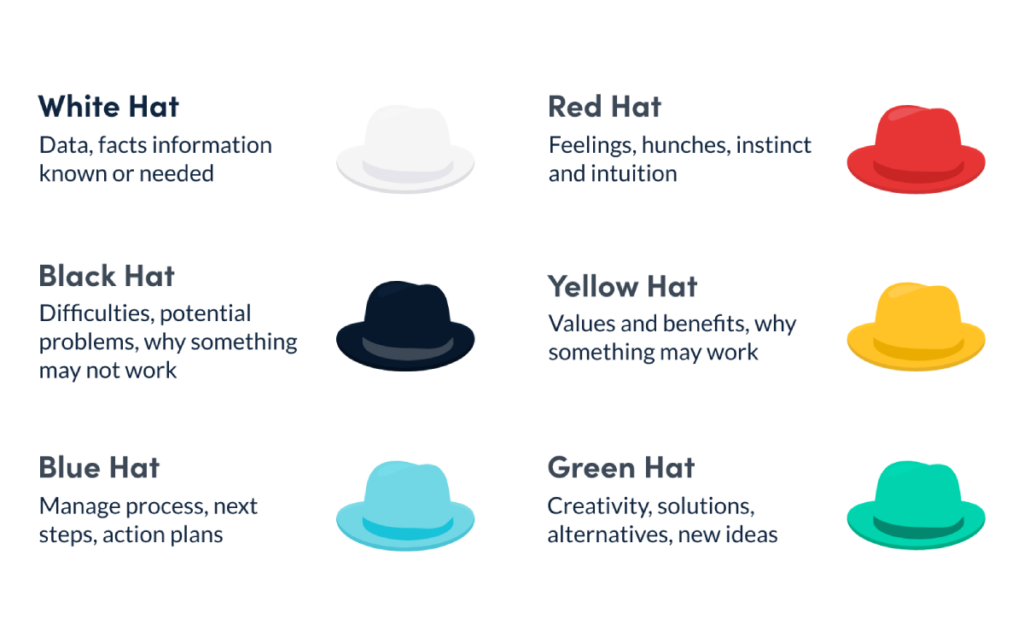One of the most powerful lessons I’ve learned in entrepreneurship is the Six Thinking Hats framework. At first, I thought decision-making was about being logical and strategic, but as I built teams and led projects, I realized something crucial—my perspective alone isn’t enough.
As a visionary, I naturally see the big picture, the future potential, and the grand possibilities. That’s my strength. But when it comes to execution, risk assessment, or evaluating different angles of a decision, I need input from other perspectives. That’s where the Six Thinking Hats method has been game-changing.
If you’re a startup founder, understanding this approach can help you make better decisions, manage your team effectively, and avoid costly blind spots.
What Are the Six Thinking Hats?
The Six Thinking Hats, created by Dr. Edward de Bono, is a method that helps teams think more clearly by approaching problems from six different perspectives. Instead of chaotic discussions where emotions and logic clash, this structured approach allows a team to analyze problems, brainstorm ideas, and make decisions efficiently.

Each hat represents a different way of thinking:
🎩 White Hat – The Facts and Data
👉 Focuses on objective information, facts, and numbers.
👉 Asks: What do we know? What data do we have? What information is missing?
👉 In a startup, this is crucial when analyzing market trends, financial reports, and customer data.
🎩 Red Hat – Emotions and Gut Feelings
👉 Focuses on instincts, intuition, and feelings.
👉 Asks: How do we feel about this decision? What’s our emotional reaction?
👉 In a startup, this is important because emotions drive customer behavior, branding, and team morale.
🎩 Black Hat – Risk and Caution
👉 Focuses on potential problems, risks, and challenges.
👉 Asks: What could go wrong? What are the weaknesses of this idea?
👉 This is the hat that prevents you from making impulsive decisions that could hurt your startup.
🎩 Yellow Hat – Optimism and Opportunities
👉 Focuses on the benefits, advantages, and opportunities.
👉 Asks: What’s the best-case scenario? How can this idea succeed?
👉 As a visionary, this is probably your favorite hat! But while optimism is essential, it needs to be balanced with realistic execution.
🎩 Green Hat – Creativity and Innovation
👉 Focuses on new ideas, brainstorming, and creative solutions.
👉 Asks: What’s a different way to approach this? How can we innovate?
👉 In a startup, this is where breakthrough ideas and disruptive innovations come from.
🎩 Blue Hat – Organization and Process
👉 Focuses on the structure, process, and next steps.
👉 Asks: How do we move forward? What’s the plan?
👉 This is critical for ensuring meetings are productive and ideas turn into action.
Why This Matters for Startup Founders
As an entrepreneur, you’ll find that you naturally lean towards certain hats. For example, if you’re a visionary, you likely wear the Yellow Hat (Optimism) and Green Hat (Creativity) often. But if you make decisions only from those perspectives, you risk ignoring Black Hat (Risks) or White Hat (Data).
In a team setting, the Six Thinking Hats allow every perspective to be considered without conflict. Instead of a team debating emotionally, this method ensures that each person plays a structured role.
💡 Example: Deciding Whether to Launch a New Product
Let’s say you’re considering launching a new product. Your team can go through these hats:
✔️ White Hat: What data shows there’s demand for this product?
✔️ Red Hat: How do customers feel about this idea?
✔️ Black Hat: What risks are involved? Can we afford failure?
✔️ Yellow Hat: What’s the potential if it succeeds?
✔️ Green Hat: Are there creative ways to make this product stand out?
✔️ Blue Hat: What’s the step-by-step plan for launching?
By using this framework, you’re not just relying on your own thinking—you’re making smarter, well-rounded decisions.
Final Advice for Startup Founders
✅ Know Your Strengths – Are you naturally a risk-taker (Yellow Hat) or cautious (Black Hat)? Understanding this helps you balance your decision-making.
✅ Build a Team That Complements You – If you’re a big-picture thinker, surround yourself with analytical thinkers, risk managers, and execution-driven people.
✅ Use the Six Thinking Hats in Meetings – Instead of chaotic discussions, have each team member focus on a specific hat. This improves clarity and reduces bias.
✅ Be Open to Different Perspectives – The biggest mistake founders make is believing their way is the only way. Learning to think from multiple angles will save you time, money, and stress.
Success in entrepreneurship isn’t just about great ideas—it’s about making the right decisions at the right time. The Six Thinking Hats framework will help you approach problems strategically and build a team that sees the full picture.
Get a free copy of the Book Six Thinking Hat by Edward de Bono
Learning never stops.
Take a moment to reflect and act on what resonates with you.
Keep evolving.
— MJ Nyota



